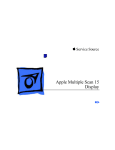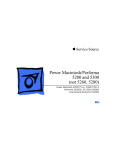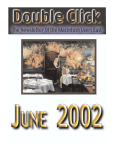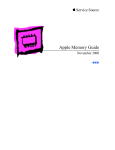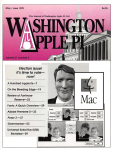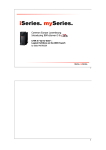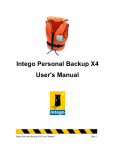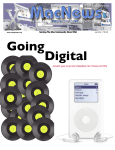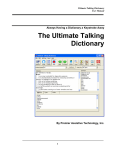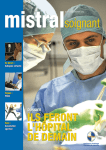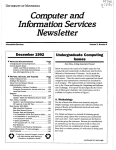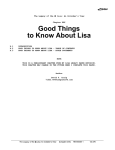Download Apple PC Power Macintosh 7220/200 User manual
Transcript
Contents AppleSauce this month... 4 Peter Carter Presidential Keyboard 6 Frank Wade Pictures 7 Images from the October meeting Peter Carter My Macs and I 8 Then and now... Wacek Jedrzejczak Family video 11 PAL, NTSC, DVD, QuickTime... Judith Watts Clues for healthy computer use 13 ‘Now, to avoid all of these nasty things...’ Brian Plush A Mac OS 10.3 Panther overview 15 New features... Frank Wade AppleSauce November 2003 1 Next ...Contents Take Control ebooks 20 ‘This ebook has been brought to you by the letter X and the number 3’ Peter Carter Which Mac System version should you be running? 21 Matching System and system Frank Wade Computing at Entropy House 27 Incoherent comment ‘The fine print’ 32 Copyright and submission information The cover picture ‘Organic’, by Brian Plush SAAUC’s database is maintained with FileMaker Previous AppleSauce November 2003 2 Contents Prescript AppleSauce this month... Peter Carter The cat is now out of the bag: Panther is on the dealers’ shelves. In this issue Frank gives us a quick overview of the new features, and we hope to have a demo at the November meeting. As you are aware, the Club is organising a bulk purchase. It will take time for the publishers of third party books to have their tomes on the shelves, but in the meantime TidBITS has begun an innovative project: publishing useful and interesting material as ebooks in PDF form. The first two relate to Panther, and from the few minutes I’ve been able to browse through them before finishing this issue I think they look good: well planned and well written, with information people will need to decide how to go about upgrading and customising Mac OS 10.3. AppleSauce The other item from Frank in this issue is the latest in his occasional series on matching OS version to machine. Wacek Jedrzejczak now uses a Mac, but he began his computer use with a very different machine, one he couldn’t even put his hands on. From punch cards he moved to dumb terminals. The Mac came later. You can read about his experiences, and his current Mac use, on page 8. I have no doubt that other members have similar experiences, worth sharing through the pages of AppleSauce. Judith Watts has become a fan of video conferencing to keep in touch with family overseas. Not as simple as just turning on the TV, what with various standards to contend with. How she manages it, with what some would consider legacy equipment, she explains on page 11. Contents November 2003 4 Next AppleSauce this month... Ergonomics used to be a ‘big thing’ in computing, but seems to be getting less emphasis these days. Brian Plush takes a break from discussing graphics in this issue (but the cover is his) to discuss exercises to keep you fit and flexible while you slave over a hot keyboard. I’ve recently taken to balancing on an exercise ball, and my usual exercise is to pull up a few weeds. Whatever your choice of diversion, take a break every now and then. Last month’s meeting was well attended, and people saw the latest in digital cameras, particularly from Nikon. Previous AppleSauce The visiting presenters used a PC, but these days any digital camera will work withMacs, and be recognised by iPhoto. The choices may seem daunting, but there are resources online, and magazines on shelves, to help you choose. And yes, we had a quick look at a G5. This month’s meeting is SIGS, with the usual offerings, although with a couple of different presenters. As is usual, the December meeting will be something special, so make a particular effort to be present on 5 December. Contents November 2003 5 Presidential Keyboard Frank Wade By the time you read this Mac OS X 10.3 will be available for sale in Australia. There is more information on this major upgrade elsewhere in this edition and at <www.apple.com.au/macosx/newfeatures/>. There will also be a presentation at SAAUC’s November meeting (7 November). This evening will also offer SIGs, and there will be an opportunity to enter a raffle to win a new 12in PowerBook or digital camera. Mac rumour sites report that new Apple displays are in the wind for a November release. Whilst you are thinking of SAAUC meetings, put Friday 5 December in your diary. This will be our last meeting for this year and there will be a number of presentations as well as our traditional special Christmas supper. Apple recently posted a net profit of $US44 million, or 12 cents a share, for its fiscal fourth quarter ended September 27. These results compare to a loss of $45 million, or 13 cents a share, in the year-ago quarter. Revenues for the quarter were $US1.715 billion, up 19 percent from the year-ago quarter. Analysts were expecting earnings of 7 cents per share, according to First Call. Apple said it shipped 787,000 Macintosh units during the quarter, up 7 percent from the yearago quarter, as well as 336,000 iPods, up 140 percent from the year-ago quarter. Apple has released new versions of QuickTime, iTunes, iCal and iSync recently, as well as completely new iBooks. SAAUC currently has 239 financial members, at least 133 of whom claim to be using a version of Mac OS X. AppleSauce Contents November 2003 6 October meeting Pictures Peter Carter Above left: Getting a close look at the G5 Left: Grant Ward points out G5 features Above right: Part of the screen, with images from one of the demonstration cameras arranged by something like iPhoto on a PC. AppleSauce Contents November 2003 7 Member experience... Then and now... My Macs and I Wacek Jedrzejczak My first contact with computers was while designing transmission towers at ETSA. We used an Adelaide University computer and had an ‘easy’ access to it via a direct line which transmitted data from a punch card reader to the university. Of course, I first had to laboriously fill in data on punch card forms, and these were used by typists to produce the cards. The university computer ran the design program, produced mountains of paper output, and also a plot of the tower being designed. Eventually we purchased our own VAX computer for engineering design. It was located in our building at Eastwood and we had access to it through terminals. They were not equipped with a mouse and the cursor was moved by keystrokes, providing a very basic way of entering and editing data. Also, for about twenty engiAppleSauce neers there were only some five terminals which we had to book in advance. But the access was much better than through one card reader! There were also one or two such strange things as personal desk computers on our floor, used by the surveyors. All this occurred towards the end of my engineering career. I intended to retire at the end of 1987 and one of my retirement projects was to be the writing of a book. I realised that a computer was necessary to undertake such a task and as I new nothing about personal computers, I talked with fellow workers who were familiar with their use. That is when Macintosh was first mentioned with the comment that, if anything, it was rather well made compared with other brands. But it was quite some time later that I eventually decided to buy a Mac. I’ve been in Australia for many years but made it a point not to lose proficiency in my native Polish, so after retirement I sat for National Accreditation Authority for Contents November 2003 8 Next My Macs and I Translators and Interpreters examinations and qualified as a professional interpreter and translator, English to Polish and Polish to English. I already possessed an Olivetti typewriter specially ordered with Polish characters which helped me to produce translations of documents. This was, however, ‘old technology’ and the next natural step was to progress to a computer. The Federal and State authorities which provided me with most of my interpreting and translating work used Macintoshes, so , to be compatible, this was the way to go. And just then I was informed that one of Adelaide’s computer firms had the Mac Plus at a special price. I went to have a look at it and was a bit disappointed with the tiny black and white screen. How would I see the full width of a page when I typed? The salesman demonstrated that this was overcome by the computer, and I purchased a Mac Plus with 1MB RAM and a floppy Previous AppleSauce drive, a separate 20MB hard disk drive, and an Apple ImageWriter II printer, all at a bargain price of $3000! I decided that I would teach myself to use the computer with the help of the comprehensive user manual. In spite of the Mac’s ease of use, it took some hours to learn the Mac basics, as some of the instructions were not clear to me, a first time user. Then I obtained word processing software, Microsoft Word 4, and fonts with additional Polish characters, and was on another learning curve. Eventually I was able to produce printed translations of quite good quality both in English and in Polish. Three years later I upgraded to a Mac LC III with 8MB RAM, internal 80MB hard drive and a 12in colour display. Now I could see the full width of the typed page without the computer having to scroll it from side to side. The Mac Plus was passed on to my two grand daughters who had no computer at that time. Soon I also changed the noisy dot matrix ImageWriter printer to an Contents November 2003 9 Next My Macs and I inkjet StyleWriter which produced a much better definition of characters. Four years elapsed before I changed the computer again. I wanted to be able to access the Internet and needed a faster computer with more RAM and a larger hard drive. I chose the Power Mac 7220/200. And as unbelievable as it may seem, I still use it today, although I added more RAM to it, replaced the CD drive with a CD burner and ‘upgraded’ to Mac OS 8.6. I know that I will not be able to use it for ever and will probably buy a G3 or a G4 in the not too distant future and venture into the new world of OS X, but for the time being my venerable 7220 still does all that I want to do. Of course, I am most grateful to the expert members of our SA Apple Users’ Club whose frequent assistance makes that possible. The Polish text on the previous page is part of an article about the Festival of Arts 2000 opera Writing to Vermeer which I wrote for a Polish monthly in Adelaide. It reads: ‘When the curtain went up, we saw the centre of the stage raised and around it there was water! At times water was also flowing down that central part of the stage, when women with brushes and buckets were washing it; at times it was streaming down from above, also on the women’s heads.’ Oh, I almost forgot! I did manage to write my book. Love’s Cadenza, a migrant’s story 1939–1956 was published in Adelaide in 1999. Previous AppleSauce Contents November 2003 10 Sending video PAL, NTSC, DVD, QuickTime... Family video Judith Watts I have long been envious of people who have family living in New Zealand, UK and other PAL friendly countries as they are able to effortlessly send video tapes to their kin. Our son resides in Alabama USA: NTSC country. We have tried a number of ways to deal with the video situation but had resorted to saving items for Kirk to view when he visits Adelaide. Now the situation seems even more complicated with the introduction of DVDs. PAL/NTSC then all those DVD area code thingys: too complicated for me! Some Club members will remember that I bought an old Panasonic video camera to use as a webcam on the Mac 5200CD when first video chatting. While Kirk and Gloria were visiting in March we took some family video for the first time. AppleSauce When the young ones returned to Alabama I got to thinking about ways I could get video of their Aussie trip to them using my Mac G3. For just an instant I wished for the latest model Mac with DVD gear :-). I then recalled that Macs older than mine had created morphed images and other fancy stuff on early video clips Contents November 2003 11 Next Family video and realized that appropriate software was probably most of my answer. I was told that it was possible to save video onto CD and if it is saved in a Windows compatible format Kirk should be able to read it. One evening I borrowed a Beatles package from the SAAUC library containing one of their movies recorded many years ago in QuickTime video. Kirk has QuickTime on his PC... Hmm... The Panasonic video camera easily connects to the composite video port on the 5200CD or the Mac G3. My TV tuner/video card has ixTV 2.15 software so I began to experiment with that. I captured freeze framed shots with no difficulty (been doing that for ages and saving as JPEG to send with e-mails) but when I tried to save a video file in the Save As dialogue box I was able to select the destination and type in the video file title but then G3 would freeze. On restart I would find my movie all present and correct but in the Trash. This file saving method was a little tedious—Save/Crash/Restart/File— so I went back to the Web for an answer. BTV Pro 5.4.3b1 is shareware which is compatible with my video card so I decided to give that the ‘15 day trial’. Previous AppleSauce BTV streams to file when capturing video and solved the Save As situation I had with the older software. I was able to save easily and now had my video files safely stored in the G3. Using Toast version 3.5.7 I burned CD copies in Mac format for us and copies in ISO 9660 format for our American connection. The final step was to make my first CD labels and our gift was ready for mailing. The family was so excited with the home made VCDs and they had no trouble viewing their holiday pictures on the PC, though my first attempts did leave some room for improvement. I will explore a little further and experiment with with settings, sound dubbing and screen sizes next time (I’d selected a postcard size sceeen this time). BTV offers 160x120 to full screen mode and has versions suitable for Mac OS 8–9 and also OS X. Well worth the registration fee in my opinion. When I perfect my G3 to VCD process what’s next? How about skipping DVD process altogether and video streaming directly from my Mac G3 to Kirk’s PC in Alabama? Contents November 2003 12 Ergonomics ‘Now, to avoid all of these nasty things...’ Clues for healthy computer use The CD is full of interesting technical information about your body. There’s not too much, but it sets the scene. Brian Plush Over the next few months I am going to share some of the ideas from a CD in the CD library that everyone should look at at least once called Clues for Healthy Computer Use. No, it isn’t about computer crashes. It’s about maintaining you, so you don’t crash! Why? Because the reality is that all those courses, all those books, all that time spent to figure out how that new, you beaut software works ain’t gonna count for zip if your pain racked body won’t let you do any more than look at the best computer in the world. This particular CD is from the MacAcademy series and consists of PowerPoint style presentations and QuickTime movies. It is North American and sounds incredibly like a personal friend of mine, so that’s very good. AppleSauce Did you know that muscles don’t know difference between physical or emotional stress, and this causes tension? Now, tension creates restricted blood flow and toxins. Toxins cause knots in muscles. Knots cause inflammation. Inflammation causes irritations which cause pins and needles, or tingling sensations and the hip bone is connected to the thigh bone which is connected to the... Just as an aside, did you know that holding a pen in your mouth (like a dog with a bone) is actually healthy? It simulates a smile and causes your body to release dopamine. So get your pen, stick it in your mouth and be healthy. Now, to avoid all of these nasty things which lead to even more nasty things like Carpal Tunnel Syndrome Contents November 2003 13 Next Clues for healthy computer use you must listen to your body and do a few little exercises. Even those totally obsessed professional computer games players in South Korea get up and go for a jog every now and then in amongst their 24–48 hour shifts at the computer. If they can, you can! Evidently the jogging keeps them fired up for the next eight hours. A very important posture type of thing to remember is to keep the elbows in. It takes the strain off your shoulders. Hey, that’s a motor sport thing too. The legendary Frank Gardner, in his white towelling hat, preached the same, but it was more about keeping yourself balanced whilst driving at a considerable rate of knots. It also applies to daily driving too. Sitting in a balanced position probably applies to working at a computer too. The exercises Okay, here are some suggested exercises that work on preventing head aches, neck aches, sore shoulders and backs. Our specific exercises are Chin Tucks, Side Bends, Shoulder Shrugs, Shoulder Blade Squeezes and finally Shoulder Rolls. Remember it’s gentle exercise five to ten times every hour. For thirty seconds... I think. Previous AppleSauce Chin Tucks are a matter of keeping your chin up and pushing forward and backward with your head and all the times keeping your head/chin on the same plane. Side Bends are the opposite way. Keep your chin in however and tilt your head gently to the left bringing it back to the upright position five or six times then repeat on the right. Do it slowly. No, it doesn’t matter which side first! Shoulder Shrugs are exactly that. Keep your head straight and lift your shoulders high. This helps relax that tight feeling which causes your shoulders to defy gravity, lift and tighten rather than lower and relax. Don’t we tell tense people to relax those shoulders? Shoulder Blade Squeezes. Place your hands behind your head, clasp them and push your elbows back gently. Shoulder Rolls are always done backwards and help avoid that hunched forward shoulder effect through sitting at the computer all day. This loosens the muscles across the front of the chest. Ohh and don’t forget that a glass of water is healthy too, unless you spill it into your computer! And you can take the pen out now. Contents November 2003 14 The latest from Apple New features... A Mac OS 10.3 Panther overview getting to the windows on your desktop called Exposé, and high quality video conferencing with iChat AV.” Frank Wade Apple released the long-awaited major update to Mac OS X for sale to Australian customers on Saturday 25 October. This overview is based on rumour, hearsay, magazine articles and Web reports, as it was prepared before the software was publicly available. Hopefully, many of the features will be demonstrated at SAAUC’s November meeting. Apple claims “Mac OS X version 10.3 Panther continues the rapid pace of innovation with industry leading applications and core technologies that redefine the desktop operating system, and Mac OS X Server version 10.3 combines the latest open source technologies with Apple’s industry-leading manageability and ease of use. “Mac OS X Panther includes more than 150 new features including a new Finder, a revolutionary way of instantly AppleSauce Other enhancements include new contextual menus, more power to Apple’s Mail application, integrated faxing into the OS, and added font management. Finder The most widely used part of Mac OS is the Finder. In Panther, Apple has updated the Finder and added some OS 9-like functionality. The new Finder has the brushed-metal look of iTunes and iPhoto. All available volumes (including iDisks) are visible in the Places sidebar on the left of the Finder window, and you can move custom files and folders to the lower part of the window, a nice addition for those who miss OS 9’s Apple menu. Redesigned Save dialog boxes also take advantage of Panther’s improved Finder interface. Contents November 2003 15 Next A Mac OS 10.3 Panther overview The new Action button brings up a contextual menu based on the current selection. It lets you perform tasks such as aliasing, printing, sending files to the Trash, and labeling files and folders by colour, an old favourite from OS 9. The Finder has a greatly improved search function, similar to the one in iTunes and Mail, which shows results as you type. Exposé Panther’s new Exposé feature can help you quickly sort through the chaos of several applications running at once. You can set keyboard shortcuts and hot corners to manage your clutter, so you don’t have to hide, move, and minimise open windows to find the one that you need. You can activate Exposé by its default function keys, set your own keyboard shortcuts, or assign each of its three viewing modes to a different corner of your screen. Once you’ve assigned a viewing mode to a screen corner, you move your cursor to that corner to switch to that mode. Choose the first mode to view all open windows. Exposé shrinks and places each window so they all fit on screen without overlapping. The more items you have open, the Previous AppleSauce smaller each window becomes (this may make it hard to identify windows, especially if you have a small monitor). But as you mouse over each minimised window, the name of the application, folder, or document appears. When you click on a window, it pops to the front and the others go back to their original positions. Contents November 2003 16 Next A Mac OS 10.3 Panther overview The second mode brings every window in the current application to the front while graying out the rest of the windows. This can be handy if you have several Photoshop documents open, for example. Select the third mode to momentarily hide all open windows so you can access something on your desktop. This makes it easy to find and open a document, unmount an iPod, or send a file to the Trash. Mail Apple’s free e-mail program, Mail, gains more power in Panther. One big addition is the ability to track e-mail threads: multiple messages with similar subject lines. Threads make it much easier to keep track of back-andforth e-mail conversations. This feature is currently part of other e-mail applications such as Microsoft Entourage and Qualcomm’s Eudora. Apple says that Mail performs faster. And now the program uses the same HTML rendering engine as Safari, so HTML messages should display more quickly and accurately. Mail also strengthens address management and Address Book ties. E-mail addresses are now objects that you can Previous AppleSauce drag between fields, and you can display your Address Book contacts as names. Other improvements are better spam filtering and a Safe Addressing feature, which highlights unfamiliar domains so you don’t accidentally send sensitive information out of your office network, for example. Font Book OS X’s Font Panel let you change font sizes and group fonts into collections, but it was far from a full-fledged font manager. Font Panel couldn’t activate or deactivate collections (handy when you have many fonts), and it worked only with some programs, so it was more a curiosity than a useful tool. Mac users who wanted help organising and managing large font collections turned to standbys such as Extensis Suitcase and DiamondSoft’s Font Reserve. Font Panel remains in Panther, but it’s joined by a new application, Font Book. Though designers may still benefit from Suitcase and Font Reserve, the rest of us may have all we need in Font Book. When you have a lot of fonts, finding a specific one can be hard. You can use Font Book to classify fonts in many ways, including by project, kind (Classic, Fixed Width, Contents November 2003 17 Next A Mac OS 10.3 Panther overview and so on), or end destination (such as a Web site). You can also control which fonts are available in a particular application. In QuarkXPress, for example, you might want to see only PostScript fonts. You can preview a typeface in Font Book and install or disable it (or an entire type family) by clicking on a button at the bottom of the Font Book window. Font Panel has also been updated. Its Character palette lets you preview a character, such as the letter N, in every active font. You can also create styles, such as shadow and underline, by combining effects and fonts. Both Font Book and Font Panel include a search function that allows you to find any font on your Mac or network. Fast user switching OS X has always been a multi-user environment. Each user has a set of applications, settings, desktop pictures, and more. Switching between users, however, has always been a tedious, disruptive process. Panther’s Fast User Switching changes that. Switching to another user no longer requires that you log out, which closes and quits all open documents and applications and then log in to another account. When Previous AppleSauce you choose a new user from a list at the far right of the menu bar, that user’s desktop immediately rotates into view, in the same state it was left in. This new feature seems ideal for home or small-office environments, where multiple people may use a single Mac. You can add or remove user accounts from Fast User Switching via the updated Accounts preference pane. More Panther enhancements Preview A new version of OS X’s built-in universal viewer is faster and has indexed text searching, PDF text copy, URL support, fax viewing, and PostScript-to-PDF and EPS-to-PDF conversion. FileVault A new feature uses the 128-bit Advanced Encryption Standard to encrypt and decrypt your Home directory’s contents on-the-fly. And the Secure Delete Trash function can completely erase files from your hard drive. Faxing Apple has bundled fax software with many Macs in the past, but Panther supports sending and receiving faxes via modem. You can now fax directly from any application that has a Print command; you can pull fax numbers from your Address Book. There’s also a Contents November 2003 18 Next A Mac OS 10.3 Panther overview new preference pane for fax management, called Print & Fax. iChat AV This update to Apple’s instant-messaging application enables audio and video chat with Apple’s $259 iSight camera or another FireWire webcam or camcorders. AppleScript Improvements to AppleScript include a redesigned Script Editor and new ImageEvents commands. Combined with the Folder Actions feature— which lets you attach scripts to folders—AppleScript can now perform a series of commands: for example, resizing images, putting the original images in another folder, and making a copy for print and a JPEG for the Web. Printing Panther’s printing software supports dragand-drop desktop printers (as in OS 9), Windows printer sharing, and a virtual PostScript printer that will let you print PostScript files to any non-PostScript printer. Don't see why I need one of those ferrite choke thingies on my tail... Previous AppleSauce Contents November 2003 19 Reading ‘This ebook has been brought to you by the letter X and the number 3’ Take Control ebooks Peter Carter The team at TidBITS has launched a new series of ebooks on topics of interest to Mac users, the first two on upgrading to and customising Mac OS X 10.3. They’re PDFs done right with bookmarks, live Web links, and so on, and can be read on screen or printed. The idea is to publish items that would be too large for magazine articles but not big enough to warrant printed books. Each book costs $US5, and purchases are via Kagi. For more info, and to begin the purchase process, see <www.tidbits.com/takecontrol/>. Anything from TidBITS is sure to be good, and the two Panther ebooks set a high standard. If you want to know more about installing and customising 10.3 add these two to your required reading. AppleSauce Contents November 2003 20 Key software Matching System and system Which Mac System version should you be running? Frank Wade Computers are doubling in speed and dropping in price about every six months. This and the size and complexity of modern programs may mean that you need to upgrade to remain productive. One answer is to buy the latest and greatest Mac, which will ship with the latest System (now called Mac OS), whilst another is to buy a processor upgrade card, which effectively puts a new faster ‘engine’ in your existing computer. However, both of these options are fairly expensive. One alternative is to ensure that you are getting the maximum out of your existing machine by running the newest version of the Operating System (OS) suitable for your Mac. Apple is currently releasing major System updates for sale about every 12 months, interspersed with minor releases, which are often freely available for download AppleSauce over the ’Net or on various give-away or inexpensive CDROMs. Each major upgrade normally improves productivity, adds new functions and makes many tasks easier and quicker. The intermediate releases are mainly bug fixes with few minor improvements. Cost is only one factor in considering an upgrade to the OS. Other factors include how much free hard disk space your Mac has, whether you have sufficient Random Access Memory (RAM) and whether your particular Mac supports the upgrade. Replacing a small hard disk with a larger one can be fairly expensive, but there are various other ways to store data away from the main hard disk and thus release space for a larger System. This also makes good sense for security and backups. Floppy disks are really only useful if you have an older Mac with a floppy drive Contents November 2003 21 Next Which Mac System version should you be running? and limited numbers of small files. There are many other options, including a second hard disk (internal or external), ZIP or JAZ drives, Super Drives, which write data to both conventional floppies and 120MB removable disks and USB flash drives. If you have a CD burner then you can back up your data to a CD. You could also use a second Mac for back-up purposes! System Released 7.0 1991 7.1 1992 7.5 1994 7.6 Previous Cost RAM for Macs is relatively cheap. You should add sufficient for the tasks that do with your Mac and the OS that you want to run. Real RAM is always superior to virtual memory. Even if you do not want to upgrade your System it is still worth adding extra RAM. Supports (See additional notes) Minimum RAM required 2MB RAM 68000, 68020, 68030, 68040, PPC 2 MB RAM? Free in 1999 68000 (barely) 68020, 68030, 68040, Power Mac (PPC) 4–8MB RAM (68x) 8–16MB (PPC) Higher figure in each case is recommended No longer available? Later 68030* 68040 and PPC Macs AppleSauce Contents Hard disk requirements/ Comments Mac Plus requires a minimum of 2MB of RAM and a HD Arguably the minimum System for effective Internet access. Last version is 7.5.5 *68030 Macs with 32-bit clean ROMs November 2003 22 Next Which Mac System version should you be running? System Released Cost Supports (See additional notes) Minimum RAM required Hard disk requirements/ Comments 8.0 Aug 97 Originally $139 68040 or PPC 12MB of physical RAM with virtual memory set to 20MB if less than 20MB of real RAM exists Minimum 125MB of HD space for easy install 8.1 Mar 98 $149 from versions earlier than 8.0 $39 from 8.0 68040 or PPC As for Mac OS 8.0 Did not work on some Performas 8.0 to 8.1 upgrade is also a free downloaded from the ’Net 8.5 Oct 98 $165 PPC only 32MB RAM (24MB physical with virtual memory set to at least 32MB) Minimum of 190MB of free hard disk space required for initial standard install 8.6 Apr 99 Free upgrade PPC only As for Mac OS 8.5 Requires 8.5 and is a free 35MB download 190– 250MB of hard disk space required Previous AppleSauce Contents November 2003 23 Next Which Mac System version should you be running? System Released Cost Supports (See additional notes) Minimum RAM required Hard disk requirements/ Comments 9.0 Oct 99 $149 PPC only 40MB RAM (32MB physical with virtual memory set to at least 40MB) 150–250MB of hard disk space depending on options 9.1 (from 9.0) Jan 01 Free download or $40 on CD-ROM PPC only 64MB RAM (32MB physical with virtual memory set to at least 40MB) 320MB of hard disk space for installation. After Restart basic System Folder is 160MB 9.1 full version Jan 01 $162 PPC only 64MB RAM (32MB physical with virtual memory set to at least 40MB) 320MB of hard disk space for installation After Restart basic System Folder is 160MB Mac OS X 10.0 Mar 01 $229 G3 or greater processor 128MB 1GB of hard disk space Includes OS 9.1 Mac OS X 10.1 Sep 01 $229 G3 or greater processor 128MB 1GB of hard disk space Includes OS 9.1 Mac OS X 10.2 Aug 02 $229 G3 or greater processor 128MB 2GB of hard disk space Previous AppleSauce Contents November 2003 24 Next Which Mac System version should you be running? System Mac OS X 10.3 Released Oct 03 Supports (See additional notes) Cost $229 G3 or greater processor Minimum RAM required 128MB Hard disk requirements/ Comments 2GB of hard disk space Notes Most versions earlier than the current one are available, but may be difficult to find locally. Apple Australia sells earlier versions. Call their Australia-wide number 133 622 for details. Processor Machine 68000 Mac Plus, SE, Classic and PowerBook 100 68020 original Mac II and LC 68030 SE 30, balance of Mac II family, Classic II, LC II, LC III and some early Performas 68040 later Performas that have a 3-digit model number, Mac LC(s) 475, 575, 580 and 630 PowerPC Macs, Performas and PowerBooks with 4 digit model numbers G3–5 All iMacs, iBooks, G3, G4 and G5 Power Macs and G processor based PowerBooks Suggested OS 68030-based Macs with limited RAM: 7.1 Later non-Power Macs: 7.6.1 Early Power Macs: 8.1 Later Power Macs with limited RAM: 8.5.1 or 8.6 Previous AppleSauce Contents November 2003 25 Next Which Mac System version should you be running? Later Power Macs with sufficient RAM: 9.x Macs with a G processor: 10.3* *Mac OS X is continuing to evolve and is currently at 10.3. Users of all G processor should consider upgrading if they meet the above specifications, ideally with more RAM than the minimum quoted. The possible exceptions are those with a processor running at less than 350MHz. These Macs will run Mac OS X, but more slowly than Mac OS 9. All very well for dogs to carry bones... Previous AppleSauce Contents November 2003 26 Incoherent comment... Computing at One assumes that Frank is a ‘little-endian’ after he wrote “The October edition of AppleSauce <eAS1003.pdf> is now available for download...” in a message to members. It’s actually eAS0310.pdf: ‘03’ is the year, ‘10’ the month, in abbreviated ISO 8601 format, which goes year, month, day, hour, minute... Never mind, you found it anyway. This year’s Ig® Nobel prize for Engineering went to ‘The late John Paul Stapp, the late Edward A Murphy Jr, and George Nichols, for jointly giving birth in 1949 to Murphy’s Law, the basic engineering principle that “If there are two or more ways to do something, and one of those ways can result in a catastrophe, someone will do it”’ <www.improb.com/ig/ig-top.html> AppleSauce Computing at Entropy House The law is usually abbreviated to ‘If anything can go wrong, it will’, but it’s instructive to look at the history. EJ Murphy was an engineer working on US Air Force rocket sled experiments to test human acceleration tolerances, the human being Major Stapp. For one experiment 16 sensors were attached to the subject’s body. There were two ways in which each sensor could be stuck to its mount, and someone had methodically fitted all 16 the wrong way round. Murphy made his pronouncement, which was quoted by Stapp a few days later at a press conference. Before long, the saying had spread to other fields, and, perhaps acting on itself, evolved to abbreviated variants. Strictly speaking, ‘Anything that can go wrong, will’ is Finagles’s Law, or in the UK, Sod’s Law. Contents November 2003 27 Next Computing at Entropy House (BTW, you now understand why USB connectors will go in only one way...) A VAX 11/780, just a grey box. In practice, there would be similar grey boxes alongside with extra disk and tape drives, and nearby, the grey wall of VMS documentation In his piece a few pages back Wacek Jedrzejczak mentioned the VAX computer. The name means ‘Virtual Address eXtension’ and VAXen were probably the most popular minicomputer of their day, 1978 to the late 1980s. They were made by Digital Equipment Corporation (DEC) and followed the PDP series. The operating system was called VMS: Virtual Memory System. It wasn’t Unix, but even Unix aficionados regarded it highly. It was secure, if slow (and it seemed to get slower with each new release). It came with a good (for its day) editor, compilers for Pascal, FORTRAN, COBOL, C, etc, and a database called DataTrieve, whose manual was written by an Australian, and therefore featured a Wombat. Terminals were also made by DEC, with the most common being the VT100. They were ‘dumb’ devices, little more than keyboard and monitor, but the VT100 did have a set of commands to position the cursor, set bold or flashing text, draw lines or boxes, and so on. That command set became an ANSI standard, used by terminal emulators all over. Previous AppleSauce VT100 terminal: as dumb terminals go a relatively smart device DEC made its name with minicomputers, and had an opportunity to be among the first with microcomputers, but neglected it. It was later taken over by Compaq, which in turn has been acquired by Hewlett Packard. Contents November 2003 28 Next Computing at Entropy House How does one edit on a terminal with no mouse? Some editors were rudimentary, and involved chasing an invisible ‘dot’ and ‘mark’ about the screen. Others, like the VMS EDT used arrow keys to move about and the numeric keypad to provide select, cut, paste, insert, etc. commands. Relatively painless, and it was possible to embed escape commands to make the VT100 display bold or flashing, or the printer to print double size, etc. left-arrow Delete one character from line being typed, and move cursor one space left ctrl X Cancel line currently being typed Fortunately the Pascal editor was far superior to that, and an EMACS-based editor came with Logo: Ctrl N for next, P for previous, B for back, F for forward, etc. Even with a mouse available, keyboard-based editing can sometimes be easier. Why do I have to use this Windows machine and not the PowerBook? Snarfed from The Australian Even so, many of the ideas that went into the PDP series and VAX, and their operating systems RSTS and VMS, live on in modern systems. A trivial example is iChat: with VMS one could ask who was online, and then type messages to and fro with phone. VMS itself has evolved into Open VMS, running on workstations and high-end PCs. Unix had its vi, and there were others such as EMACS. Certainly better than editing programs on the Apple II: esc A Move cursor one space right esc B Move cursor one space left esc C Move cursor one space down esc D Move cursor one space up right-arrow Enter character under cursor into memory, and move cursor one space right Previous AppleSauce Contents Keep your paws off me! November 2003 29 Next Computing at Entropy House Every time you shut down your Mac it goes through some routines to make sure that all files are closed properly and everything is tidy. Takes time. (And after a Word .doc that came by e-mail crashed Word twice one gave up on it, and told the sender so.) Had occasion to plug flash drive into client’s Windows Every time you start the Mac up again it runs some rou- XP PC to collect some files for their publication. Usual tines that check that everything is, in fact, as it should be. person wasn’t in, and other person wasn’t sure what was where on the machine. Eventually transferred the files, (If it isn’t, you’ll get a message.) Takes more time. but might have been easier to key cd xxx a few times A group at Stanford University in the US has come to the and then copy merchandise.txt e:. That Windows conclusion that the shutdown and startup routines GUI just gets in the way at times. duplicate their efforts, and that the shutdown routines could be eliminated. Their tests show that it’s quicker to When the job was finished put it on CD and took it to the printer. Phone call came later in the morning: both PCs simply turn the computer off, or crash it. refused to read it (Even though worked OK on both For Red Hat Linux a proper shutdown and restart takes machines here). Went home, made another, and took 105 seconds, a crash and restart 75 seconds. For Winthat in. Second one worked. dows XP the figures are 62 and 48 seconds. (The reader MacSkate is a device made by Marathon Computer is invited to experiment with Mac OS 9 and OS X.) <www.marathoncomputer.com/macskate.html> Saving a few seconds at shutdown and restart may not to put wheels under Macs: ‘The four full-swiveling castsound like much, but accepting crashes as normal can ers let it slip around corners as agile and sure-footed as a actually save time with critical systems. Rather than havcat.’ ing fault detection code that shuts things down carefully Hmm... Cat and mouse around the monitor? They’ll need and restarts, simply allowing a program to crash and to redesign it for the G5. then restarting has things working again more quickly. Previous AppleSauce Contents November 2003 30 Next Computing at Entropy House And should you want to put wheels under an iMac, you might consider the igo4mac stand, from <www.igo4mac.com>. Someone at Microsoft, it seems, is unhappy that iTunes for Windows is a closed system, limiting users to purchasing from Apple’s site. Sounds like one utensil accusing another of being covered in carbon. Very thoughtful of ‘Microsoft’ to e-mail multiple copies of ‘security patches’ to Entropy House (where Word 98 is the only MS code in use (and then only occasionally)), and another to the Club mailing list. Nice little image, but trashed the rest (which would undoubtedly have made a mess of a PC). Lost for words? Take a look at <phrontistery. 50megs.com/clw.html>. A quote to finish with: “In the year 2003 the Internet is now mission critical for all customers.” Zigmunt Edward Switkowski, PhD Previous AppleSauce Contents November 2003 31 EJECTOR SEAT ‘The fine print...’ Advertising AppleSauce is the official organ of SAAUC Inc., and is published Small advertisements from financial members will be accepted and published free of charge, provided they are signed by the person(s) placing the advertisement. eleven times per year, February–December. AppleSauce is an independent production and has not been Guidelines for Contributors Business advertising rate is $50.00 per page (or by negotiation) with submission as PDF file. Page size is 225 * 160mm/640 * 460 pixels, and commercial advertising deadline is the second Friday of the month. Articles and artwork on any topic relating to Apple computers are welcomed. E-mail to the Editor <[email protected]>, or post to the Editor’s business address (Pelagos Productions, PO Box 133 Brooklyn Park 5032). Advertisements must not conflict with the interests of the club. Publication does not imply recommendation or endorsement by SAAUC Inc. authorised, sponsored or otherwise approved by Apple Computer Inc. Deadline is the third Friday of the preceding month. Copyright Submissions must be spell checked, in ASCII text format (.txt, not Word .doc or AppleWorks .cwk), with graphics as separate files: please use JPEG for photographs and similar, GIF for line art. (If in doubt, please ask.) Except where otherwise stated, this publication is copyright © 2003 by SAAUC Inc. Authors and advertisers express their own opinions and are responsible for the accuracy of their submissions. The Editor reserves the right to edit as required: authors will be contacted if major surgery is necessary. Permission is granted for the reproduction of original articles contained in this issue by any non-profit organisation provided the author, title and publication credits are given, and a copy of the publication is sent to SAAUC. Contact the editor for text and graphics files. AppleSauce is edited and laid out with FrameMaker, with a bit of help from BBEdit, Photoshop, Illustrator, etc. before conversion to Acrobat. AppleSauce Contents November 2003 32
































